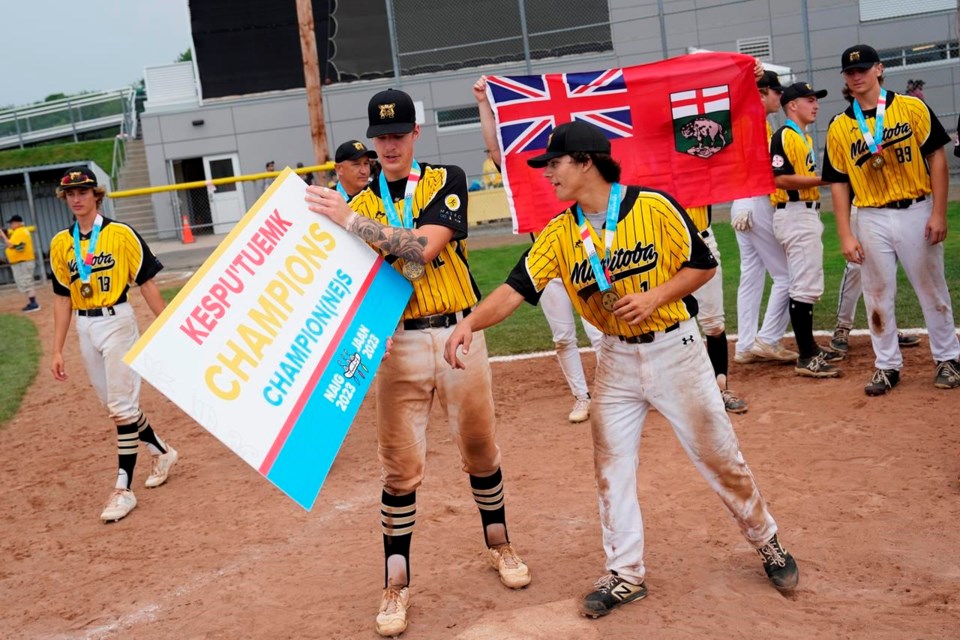HALIFAX — Baseball is known as America's game, but there were signs Friday on a misty Halifax field that First Nations and Métis athletes from Canada are increasingly adopting it as their own.
At the North American Indigenous Games in Halifax, Brandon Beaudin-Herney coached his Saskatchewan team to a 2-1 comeback win over Ontario for the bronze medal at the 19-and-under youth tournament.
As his athletes presented team captain Tegan Nahnepowisk with a birthday cake at home plate, the coach described a connection between Indigenous values and baseball.
"Sports are the heart and soul of most First Nations communities. It brings the people together, brings community together," said Beaudin-Herney, a former U.S. junior college player who runs an emergency shelter in Regina.
"With this team, we have a community of people who care, who respect the game, who respect each other, and that connects to core Indigenous values," said the 29-year-old coach, whose father is Mi'kmaq and mother is Saulteaux.
"We have kids from urban communities and kids from on reserve, and they're meshing."
Over 100 Indigenous athletes, along with about 20 coaches, were swinging bats on the Beazley field in the Halifax suburb of Dartmouth this week, often in front of large and vocal crowds of about 200 people.
Among them are a rising number of elite athletes, which Herney-Beaudin attributes to support from both Indigenous organizations and non-Indigenous baseball organizers who are mentoring Indigenous athletes.
Beaudin-Herney was among the first generation of Indigenous baseball players to be chosen for a National Junior College Athletic Association team, spending several years playing in Monterey, Calif.
Now, many of the top players at the Indigenous games are playing at colleges in Canada and the United States.
In Friday's gold medal matchup, Manitoba catcher Cody Gunderson, who plays for a junior college team in Hutchinson, Kansas, was intentionally walked four times by a Wisconsin team that feared his hitting power. His team nonetheless marched to an 11-0 win due to overpowering pitching and seamless field play.
Gunderson, 18, who is Métis from Saint Malo, Man., said in an interview he's hoping to be drafted to play at a higher level. "It's nice to have kids looking up to me and asking questions. Hopefully that helps them out, just as it helped me," he said.
His teammate, Ryder Duncan, who is also Métis, said, "as you can see, our sport has a lot of Métis players, and it's good to have a community you can go to where you feel supported."
Beaudin-Herney said the Indigenous games are all part of a wider development of the sport.
¬Ý"We're trying to get more representation (in baseball) from Indigenous communities, and it starts with the North American Indigenous Games, where we get those players highlighted and viewed by midget and triple-A (baseball) directors," he said.
As the bronze-medal game unfolded on Friday, the 29-year-old coach's playing experience showed, as he calmly directed his second baseman to bunt and put a runner into position to score a tying run.
Beaudin-Herney said part of his approach to coaching has been to introduce Indigenous cultural practices to the young athletes.
"One of my goals is to really reconnect with who you are as an Indigenous person and find yourself, and the boys have taken to it, and they love it," he said.
There have been morning smudging and pipe ceremonies. "We wanted to get a team sweat in, but couldn't manage it," said Beaudin-Herney, referring to the sweat-lodge purification –°¿∂ ”∆µ.
Beaudin-Herney's mother, Erica Beaudin, the chief of Cowessess First Nation in southern Saskatchewan, said in an interview that baseball teams draw from the growing numbers of softball and fastball leagues in Indigenous communities.¬Ý
She said in the residential school era, there was little support for Indigenous youth sport, and as a result sports that require minimal equipment, such as basketball and baseball have been adopted more quickly.
However, she added that Indigenous baseball players continue to face a ceiling when they reach the more elite levels of the sport and costs start to mount for parents for travel and gear.¬Ý
She said that's changing, amid the wider development of Indigenous athletics, support from provincial programs and the growing view that baseball fits nicely into First Nations values.
"Baseball is very simple. It develops athleticism and it develops character," she said.
Final sports competitions at the Games wrap up on Saturday.
This report by The Canadian Press was first published July 21, 2023.
Michael Tutton, The Canadian Press




